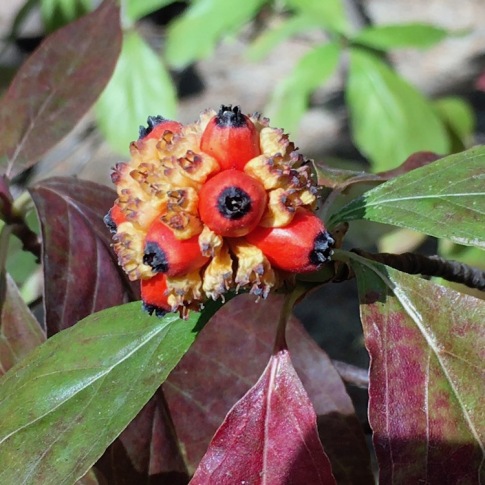The last trip to our cabin in Fish Camp near Yosemite National Park had a few hours for leisurely walks and Yatzhee! on the wraparound deck but was mostly about accomplishing chores necessary for the coming winter. We take the removable snow rails down from the deck and pull out the painted plywood snow doors for installation on two of our three entry doors. With central heat and a nice wood stove, we make use the cabin every few weeks throughout the cold season. It’s impossible to know whether we will have 10 feet of snow or none at all and so the smart money is to be prepared for whatever comes well in advance the the first icy flakes.
In my 2018 post Dogwood day…Memorial Day I featured bloom photos from the lone Cornus nuttalii, Pacific dogwood, on our property. I’ve since found that we have one other but certainly that’s not really the making of a dogwood forest, especially when the spring blooms bursting out along the highway to our place have almost a wedding like feel. On this visit the dogwood’s leaves are starting to show their fall color.


Shaded by a high canopy of cedars, firs and pines it is a little hard to see the russet and purple tones creeping in.

I got pretty excited when I saw a number of seed clusters well within my reach–maybe I can grow my own little dogwood forest! I texted my native plant mentor Ann for counsel and spent a bit of time on a few California native plant propagations sites to get a sense of the best way to go. The consensus was that directly sowing the seeds would probably be more successful than trying to start in pots. I was amazed to learn that germination could take up to 18 months!! Seed collection is #1 on my to-do list for our next trip–hopefully I won’t have missed my window of opportunity.
Number one of this trip’s list was to take care of our wood supply for the winter. We are able to cut firewood every year in specific amounts and from designated locations on public lands with US Forest Service permits. Every couple of years we supplement that supply with a load of cured and cut almond.

In preparation for the new wood we shift the older wood remaining on the second set of wood cribs to the front one, making a nice open space for the new wood to be delivered. Even with two sets of hands this is a several hour job.

The weight of the wood truck (this one hauling 4 cords of wood stacked in the bed with vertical partitions separating each cord) dictates that the wood must be dumped at the TOP of our year old asphalt driveway–the truck could come down but would never be able to get back up!


Our wood moving method involves Dave backing up our truck to the pile. We then fill up the bed, drive the truck down the hill and back it up near the wood cribs and unload it into another pile…three times. A strong motivating factor is that we cannot drive off our property until the wood is moved.

Then that big pile gets stacked onto the empty crib. The whole process takes about six or seven hours. Dave is strong and I am slow but steady. I am not sure I would have survived “the olden days”. He always gets the honor of placing the last log. With every stick tucked in its spot both piles get tarps and bungee cords to keep the wood dry. We use these two wood storage stacks to refresh the smaller wood supplies kept closer to the cabin. I am here to tell you this work makes even the most strenuous garden tasks seem lightweight!


My husband and I have handled a lot of firewood in our lives and my husband’s name is Dave also. We have slowed down a lot in retirement, but my Dave is great with a chain saw and I can still load and stack wood pretty good. Those dogwoods are beautiful. I have tried to grow them several times without too much luck. They grow everywhere here in Arkansas. Liked your post.
LikeLike
Wish me luck on getting those seeds to germinate!
>
LikeLiked by 1 person
I do wish you luck on your seed germination.
LikeLike
Very Cool Post❤️
Liz
LikeLike
We used to grow dogwood at the farm, but the market was limited. Most of our clients are in chaparral climates, where they should not plant dogwoods. I work in landscapes with a few types, including one that I believe to be Cornus nuttallii or a hybrid of such. It makes enough fruit to be a mess.
LikeLike